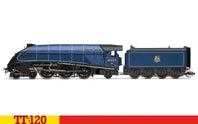SALE - Hornby TT3009M BR Class A4 Class 4-6-2 60025 'Falcon' - Era 4
SALE - Hornby TT3009M BR Class A4 Class 4-6-2 60025 'Falcon' - Era 4
Hornby TT:120
Couldn't load pickup availability
Hornby TT3009M BR Class A4 Class 4-6-2 60025 'Falcon' - Era 4
The LNER Gresley A4 is one of the most iconic express locomotives in Great Britain, with its streamlined casing a classic symbol of the attitude towards speed and design in the 1930s, which saw increased competition to the railways from road and air travel. The LNER Board knew that they had to make travel between the major cities faster, comfortable and more reliable.
Nigel Gresley, the LNER's Chief Mechanical Officer, travelled on the Fliegende Hamburger diesel locomotive in Germany and was impressed by its streamlining, although he realized it was only efficient at high speeds. Gresley was certain that a modified A3 Pacific, with streamlining, could haul greater loads than other locomotives at the same speed or faster and a series of trials were conducted to confirm the A3's suitability.
With the trials successfully completed, the LNER Board gave Gresley the go-ahead to create the "Silver Jubilee" streamlined trains, the first of the new streamlined A4s.The streamlining of the A4s' steam circuit, higher boiler pressure and extension of the firebox to create a combustion chamber made them more efficient than the A3 as they consumed less coal and water- especially later on when they were also fitted with a Kylchap double chimney. This improved their free steaming capabilities further. Their streamlined design not only made them capable of high speeds, but created an up draught of smoke, obscuring the driver's vision, a major problem on the new Class A4 engines. The story goes that during wind tunnel testing, after several unsuccessful efforts to get the smoke to lift clear, a thumbprint was inadvertently left on the clay model just behind the chimney. This succeeded in clearing the smoke and was incorporated into the final design.
4484 Falcon entered service with LNER in January of 1937, following the broad early naming format based around Gresley’s penchant for birds. The locomotive would go on to serve under BR as 60025 before being scrapped in October of 1963.


